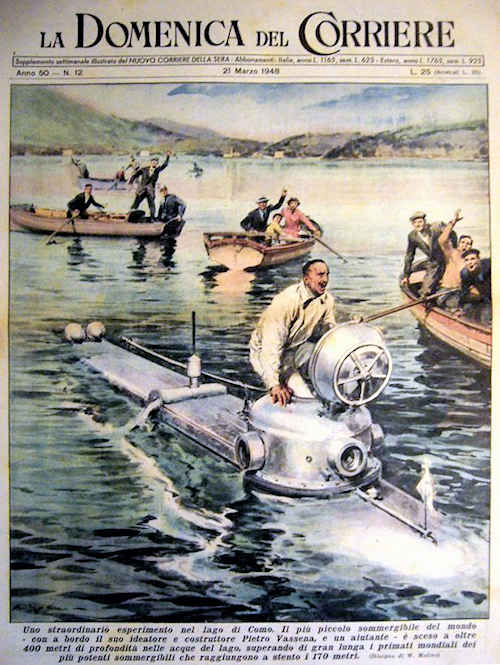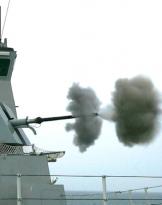Today we want to remember Pietro Luigi Vassena, an Italian inventor who engineered and developed many inventions in the last century, amazing the world to the point of obtaining a degree Honorary in engineering from the Politecnico di Milano.
Pietro Luigi Vassena was born into a family of humble origins and was only able to study up to the third grade in his hometown, Malgrate, in the productive area of Lecco. Having to work as an apprentice in his parents' inn, he soon left his studies, remaining however always fascinated by the developments in technology and the functioning of machinery.
After the First World War, where he had fought as a bersagliere, he worked at the Faini company where he was able to apply his inventiveness to industrial machinery, designing and building a 100cc motorcycle.
Among the many inventions, in 1930 he experimented and patented the system skivass, a curious technological-sporting invention halfway between skis and a canoe to be able to walk on water (following photo).

A past in marine direction and the creation of the C3
Pietro Vassena had in the past studied the functioning of submarines, having collaborated with the Regia Marina in research for the development of assault craft; in particular, he had created a prototype of an underwater boat (later built in the Badoni factory in Lecco) which had the purpose of launching torpedoes. The vessel, defined as an "assault vessel with torpedo", should have been capable of navigating at 45 knots on the surface and 30 underwater but it was not followed up.
At the end of the war, participation in the Republic of Salò cost him dearly: he was arrested and placed in what he called the "college", the old schools in via Ghislanzoni, transformed into a prison in 1945, immediately after the Liberation.
After the war, in 1946, the Shipbuilding Section of the Ministry of Industry. Pietro Vassena, looking for concrete help, presented himself in search of funding to realize his greatest dream, to build a bathyscaphe, a boat to be able to dive to great depths. It was a fruitful visit, because it allowed him to meet the engineer Guglielmo Premuda, an expert in submarines, who was intrigued by that man who was so sure of himself, always optimistic despite having gone through many hardships, who spoke with technical competence. Premuda followed him to the workshop in via Cavour in Lecco, a small craft shop where Vassena had made many inventions including a small outboard motor, becoming the holder of various patents.

To give greater importance to his project, in his presentation to the engineer Premuda, he invented that the "C3", was his third realization in that field. In reality, that acronym arose from the fact that when he had begun to study how to make the bathyscaphe, he was lodged in cell No. 3 of the "college" in which he had been confined, the old schools in via Ghislanzoni, transformed into a prison in 1945, immediately after the Liberty.
 In short, the inventor showed Premuda a model of the "C3" placed inside a tank. By means of a modified bicycle pump, he could make it submerge or emerge; technically it wasn't such an innovative thing, but it was the man's enthusiasm, his evident intuitive and mechanical abilities, that appealed to the engineer Premuda who, unable to support him financially, sent his son Tullio to Lecco .
In short, the inventor showed Premuda a model of the "C3" placed inside a tank. By means of a modified bicycle pump, he could make it submerge or emerge; technically it wasn't such an innovative thing, but it was the man's enthusiasm, his evident intuitive and mechanical abilities, that appealed to the engineer Premuda who, unable to support him financially, sent his son Tullio to Lecco .
Thus it was that, in that fervent atmosphere, the "C3" was born, immediately announced in the local press; In this adventure he will be accompanied in the autumn of 1947 by Nino Turati, a 30-year-old former submariner who had offered to go down with him, sharing his previous experience.
After months of acclimatization tests, we said playing cards inside the vessel to get used to being in a closed hull, on February 19, 1948 the "C3", loaded on a homemade trailer (obviously built by Vassena) left the yard of via Cavour and was transported to the lake towed by a truck.
At the moment of the launch, once again opportunely publicized in the local press, the bathyscaphe was placed in the cold and gray waters of the lake, under the eyes of many onlookers. On that occasion, Vassena made four dives and, on Sunday 6 March, with Turati, his son Angioletto, the journalist Gian Piero Gerosa and a young lady who had impulsively declared that she was not afraid.
 The "C3" begins to descend and reaches a depth of 55 meters without showing any problems. At this point Vassena was unstoppable and, two days later, she moved with the vessel to Argegno, on the Como branch of the Lario, where the depths were greater, and descended unmanned to 235 metres.
The "C3" begins to descend and reaches a depth of 55 meters without showing any problems. At this point Vassena was unstoppable and, two days later, she moved with the vessel to Argegno, on the Como branch of the Lario, where the depths were greater, and descended unmanned to 235 metres.
On 10 March, the "C3", harnessed with cables hooked to a powerful crane installed on a "comballo", the characteristic barge of the Lario, descends up to 405 meters; when she gets back up, Vassena and Turati rush to open the hatch, enthusiastic.
It is perfectly dry and now we have to go down with the crew. On March 12 they will get the world record of 412 meters reached with a self-propelled apparatus (that is, not with a bathysphere), at a depth almost quadruple that reached by submarines of the time.
The news went around the world and all the greats, including the famous Swiss physicist and explorer Auguste Piccard, went to the lake to get to know him and the bathyscaphe soil. Even the Italian navy is beginning to take an interest in a future scientific use.
In July the C3 is transported to the Gulf of Tigullio, and then to Naples, to search for deeper waters than those of the lake near Capri in order to continue the experiments.
Diving in the sea
The first test dives are successful. The well-known journalist Nantas Salvalaggio, correspondent of the newspaper, also goes down with him in the bathyscaphe Il Tempo. But the enthusiasm and haste are felt.
At 8:45 on 8 October, while the bathyscaphe was being towed, inexplicably with the turret open, the "C3" began to take on water and sank; a superficiality that is resolved, four days later, thanks to the intervention of the Navy, which through its underwater departments manages to sling the hull of the submarine and bring it back to the surface.
But that wasn't all: new levity and perhaps too much enthusiasm will cause a second and definitive sinking on November 20th.

After the necessary repairs, the bathyscaphe is carried offshore by tug Tenacious (ex US Army LT 154 – large tug 154 - photo), to bring it vertically to the point chosen to attempt the descent to a depth of 978 meters (always unmanned); due to a technical and maneuvering error, an overheated cable suddenly breaks with its yielding and sudden detachment from the support crane. The bathyscaphe, now without brakes, thus sinks into the abyss on a seabed that is too high to be identified and recovered.
The adventure of Pietro Vassena and his bathyscaphe C3 will end that day; the story of a self-taught with the third grade but so creative that in 1940 the Politecnico di Milano had awarded him the degree Honorary in Engineering, and of the C3, defined in the US Navy Register on "first half submarine of peace, for scientific research".
Indebted Vassena will end his life as a dreamer in a petrol station which, on his merits, Agip gave him in concession in Malgrate, the town where he was born on April 21, 1897, and where he will disappear on May 21, 1967.
Photo: web
(article originally published on https://www.ocean4future.org)












